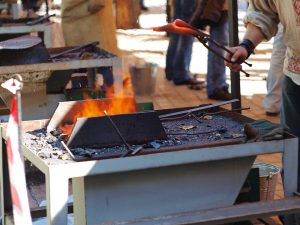
Based on its name alone, you may assume that tempered steel is a unique type of steel with a specific ratio of iron to carbon. While tempered steel is, in fact, an iron alloy, it still has the same amount of iron and carbon as conventional steel. Nonetheless, tempered steel offers a superior level of strength, making it preferable for certain manufacturing applications.
Overview of Tempered Steel
Tempered steel is steel that’s been treated with heat — below its melting point, which is around 2,500 degrees Fahrenheit — and then cooled for the purpose of improving its physical properties. It’s used to increase the strength, hardness and roughness of steel. When steel is heated and cooled, its physical properties change.
Tempered steel has been around for centuries. In feudal Japan, bladesmiths would make katanas and other bladed weapons using tempered steels. The process involved slathering clay around specific parts of a steel blade, heating the blade in a furnace, and then quenching the blade in water.
Since then, new metalworking processes have emerged, but the overall concept of tempering remains the same. To temper steel, the steel is heated to a specific temperature below its melting point, followed by cooling the steel.
Benefits of Tempered Steel
The primary benefit of tempered steel is increased strength. When steel is heated and cooled, it becomes stronger. As a result, it can withstand greater force without succumbing to deformation. Tempered steel is also more resistant to wear and tear. For high-stress applications, this alone is reason enough for manufacturing companies to choose tempered steel over other types of steel.
Tempered vs Annealed Steel: What’s the Difference?
Both annealing and tempering involve heating and cooling steel to improve its physical properties. With that said, however, tempered steel isn’t the same as annealed steel. Annealing is a metalworking process that uses a slower and more controlled method of cooling, whereas tempering is a metalworking process that uses a faster and less-controlled method of cooling. With annealing, steel is heated to a specific temperature, after which it’s cooled slowly over a long period. Annealed steel has improved electrical conductivity than its tempered counterpart, but tempered steel offers superior strength and hardness.
Steel isn’t the only metal that can be tempered. Countless other metals and alloys can be tempered. Tempered steel, however, offers several attractive qualities when compared to other tempered metals and alloys.
